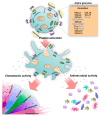Recent Advances in the Discovery and Function of Antimicrobial Molecules in Platelets
- PMID: 34638568
- PMCID: PMC8508203
- DOI: 10.3390/ijms221910230
Recent Advances in the Discovery and Function of Antimicrobial Molecules in Platelets
Abstract
The conventional function described for platelets is maintaining vascular integrity. Nevertheless, increasing evidence reveals that platelets can additionally play a crucial role in responding against microorganisms. Activated platelets release molecules with antimicrobial activity. This ability was first demonstrated in rabbit serum after coagulation and later in rabbit platelets stimulated with thrombin. Currently, multiple discoveries have allowed the identification and characterization of PMPs (platelet microbicidal proteins) and opened the way to identify kinocidins and CHDPs (cationic host defense peptides) in human platelets. These molecules are endowed with microbicidal activity through different mechanisms that broaden the platelet participation in normal and pathologic conditions. Therefore, this review aims to integrate the currently described platelet molecules with antimicrobial properties by summarizing the pathways towards their identification, characterization, and functional evaluation that have promoted new avenues for studying platelets based on kinocidins and CHDPs secretion.
Keywords: CHDPs (cationic host defense peptides); kinocidins; platelet microbicidal proteins (PMP); platelets.
Conflict of interest statement
The authors declare that there are no conflict of interest.
Figures





References
Publication types
MeSH terms
Substances
LinkOut - more resources
Full Text Sources

